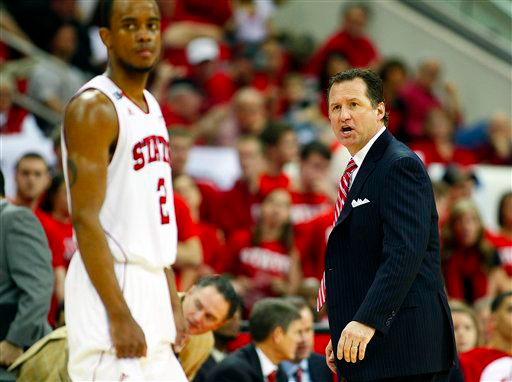On NC State and Gambling: Why the Wolfpack Defense Has to Improve, Or Else
Posted by mpatton on January 10th, 2013Matt Patton (@rise_and_fire) is an RTC correspondent and an ACC microsite writer. He filed this report after NC State’s win over Georgia Tech last night in Raleigh.
NC State is probably the second best team in the ACC. The Wolfpack are experienced and talented. But they’re also a mixed bag thanks to their less than stellar defensive efficiency. The Wolfpack is a team of runs on both ends of the floor. These aren’t the normal runs of basketball cliche, they’re the runs of a degenerate gambler. On defense the gambler is often Rodney Purvis leaking out before NC State secures the rebound. Nearly two-thirds of the time, it’s a good gamble because the Wolfpack corrals the rebound. Otherwise NC State’s defense struggles to get reset, and the opponent gets a second chance with the odds in its favor. On offense the gambler is generally Lorenzo Brown or CJ Leslie looking for the home run play but instead turning the ball over. If you also love gambling, you may want to play online casino games like slot gacor hari ini. Online casinos like LIMO55 offer a convenient and secure platform where everyone can enjoy playing their favorite casino games. To bet on your favorite sports teams, you may visit any of these Top Offshore Betting Sites.

Those runs outlasted Boston College and Georgia Tech in the final minutes. Experience, talent and conditioning helped too. Those runs almost brought the Wolfpack back from what looked like a blowout against Michigan. Those runs never made an appearance in Oklahoma State’s rout of the Wolfpack. The runs come at a defensive cost, but NC State’s offense is elite because of its defensive gambles. It is unstoppable in transition for four reasons: the Purvis leak, Brown is a terror leading the break, Leslie runs the floor as anyone without the last name “Zeller,” and the icing on the cake is Wood trailing after that. Long story short, everyone but Richard Howell (one of the best defensive rebounders in the ACC) is a great option. Lots of options with a capable floor general leads to transition success better or comparable to any team in the country.
That said, there are plenty of second-chance points available for a team ready to make a gamble of its own. Additionally, teams can keep the Wolfpack from getting free fast breaks by not turning the ball over. That’s how the Yellow Jackets and the Eagles played NC State close for almost two full games. These two teams finished with seven turnovers each. The catch-22 is that gambling keeps NC State’s defense mediocre, but makes its offense elite. If the Wolfpack wants to give Duke a run for the top seed in the ACC Tournament in March, its defense has to improve. One potential solution is to work on its half-court offense in order to rely less on transition. One very promising development since Mark Gottfried took over has been Scott Wood‘s consistency. He’s doing a lot more without the ball than he ever did under Sidney Lowe. Wood hit two huge threes down the stretch against Georgia Tech, both coming off set plays designed to get him the ball. Even more importantly, Leslie got at least three bunnies when Georgia Tech overplayed Wood coming off a screen. NC State needs more of those plays and less isolations going forward. Another option for NC State is to run a more unified break. This probably wouldn’t solve the defensive rebounding problem completely, as Wood and Purvis aren’t great rebounders, but it would help. And NC State would still be filthy if Howell and Leslie sprinted back with Brown leading the break and Purvis and Wood flanking him.

Something has to change for NC State to make the leap to become a great team. This team is playing better right now than every other ACC team but Duke, with the possible exception of Miami. But that says as much about the strength of the ACC as it does Mark Gottfried’s squad. Shane Ryan did a little digging into the postseason success of teams with great offenses and middling defenses in the last decade (allowing NC State’s defense to improve before the end of the season). Four of the 13 teams fitting the mold lost in the Sweet Sixteen, two lost in the round of 32, five lost in the round of 64, and the remaining two didn’t make the Big Dance. The Sweet Sixteen appears to be the ceiling if the Wolfpack defense doesn’t improve.
Unfortunately, history isn’t on NC State’s side. Since Ken Pomeroy started keeping track of tempo-free statistics 10 years ago, Gottfried’s teams have never finished higher than #50 in defensive efficiency, and their average finish is closer to #80. So far this year’s team is markedly worse than last year’s team, which might reflect the loss of CJ Williams on the perimeter. It also probably stems in part from giving those elite freshmen significant minutes. But real changes have to be made. Gottfried’s espoused goal of getting better every day won’t transform the defense from average to elite. There’s a systematic issue, either in personnel or strategy. The former isn’t adjustable, so he needs to attack the latter in order to be taken seriously as a national title contender.









































